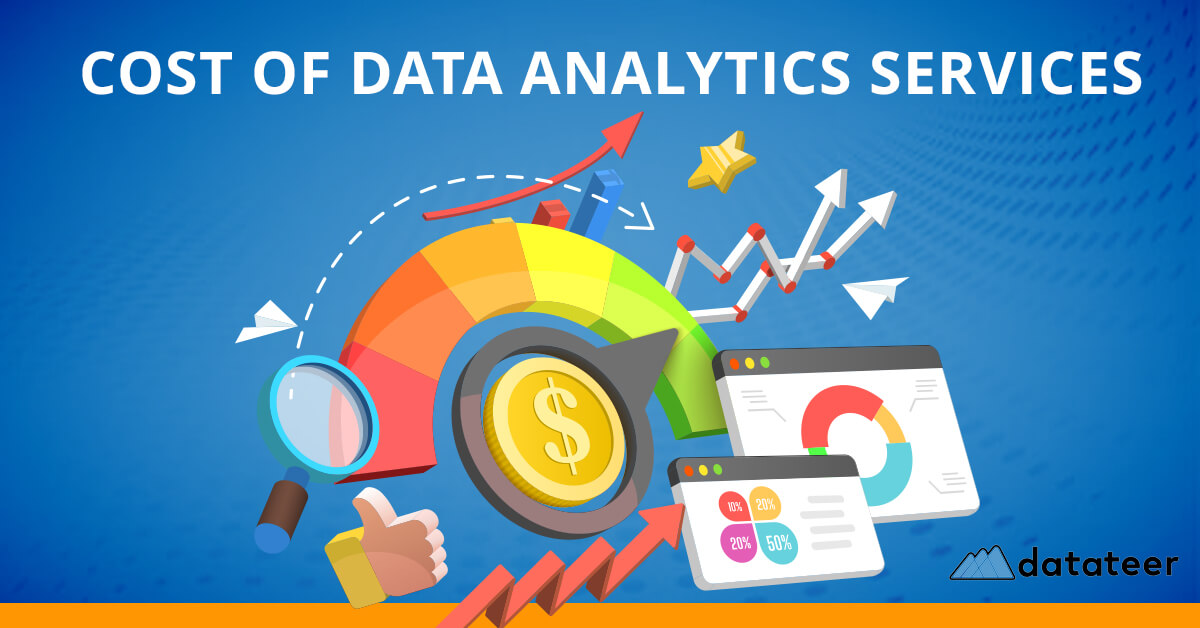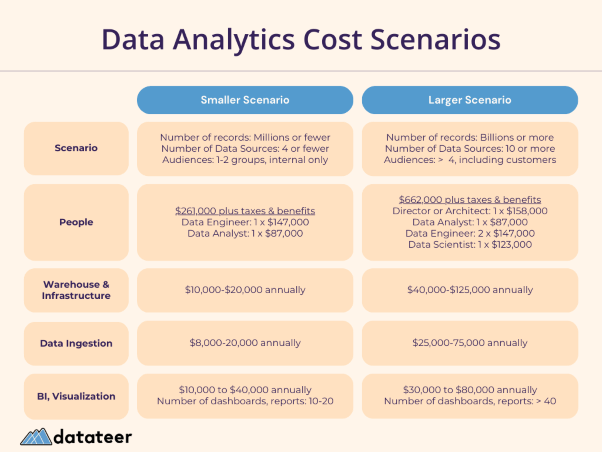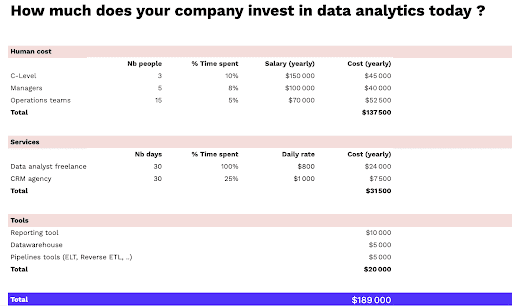Understanding the costs of data analytics can seem complex. Businesses often wonder if the investment is worth it.
Data analytics is crucial in today’s digital world. It helps companies make informed decisions, streamline operations, and improve customer experiences. But how much does it cost? The answer depends on various factors. These include the size of your business, the tools you choose, and the scope of your data needs.
This blog will break down the different costs involved in data analytics. We’ll explore software expenses, hiring experts, and ongoing maintenance. By the end, you’ll have a clearer picture of what to expect. So, let’s dive in and demystify the costs of data analytics.
Introduction To Data Analytics Costs
Data analytics is crucial for making informed decisions. But understanding its costs is equally important. Knowing where your money goes helps in managing resources better. This blog post breaks down the key aspects of data analytics costs. We will explore the importance of cost management and the factors influencing costs.
Importance Of Cost Management
Managing costs in data analytics helps in optimizing resources. It ensures you get the best value for your investment. Proper cost management can prevent overspending. It also helps in allocating funds to the most critical areas. This way, you can achieve your business goals without financial strain.
Efficient cost management leads to better ROI. It helps in identifying areas where you can cut costs. This frees up resources for other important projects. It also ensures that your data analytics efforts are sustainable in the long run.
Factors Influencing Costs
Several factors influence the costs of data analytics. Understanding these can help you plan your budget better.
| Factor | Explanation |
|---|---|
| Data Volume | The amount of data processed can increase costs. |
| Tools and Software | Advanced tools may have higher costs but offer better insights. |
| Human Resources | Skilled professionals are needed to analyze data. |
| Storage Solutions | Storing large datasets requires significant investment. |
| Training and Development | Continuous learning is essential for staying updated. |
Data volume is a major factor. More data means more processing power and storage. This increases your costs. Tools and software also play a role. Advanced tools can be expensive, but they offer better insights. Human resources are another significant cost. Skilled professionals are needed to analyze the data. Their salaries add to the overall cost.
Storage solutions are also essential. Storing large datasets requires significant investment. Lastly, training and development are crucial. Continuous learning is essential for staying updated with the latest trends.

Credit: www.veritis.com
Initial Setup Costs
Setting up a data analytics system involves various initial costs. These costs are crucial for the efficient operation of your data analytics infrastructure. Understanding these costs can help you budget effectively.
Hardware And Software Investment
Hardware and software investments are the backbone of any data analytics setup. This includes the purchase of servers, storage devices, and network equipment. Quality hardware ensures your system runs smoothly and efficiently.
| Item | Estimated Cost |
|---|---|
| Servers | $5,000 – $10,000 |
| Storage Devices | $2,000 – $5,000 |
| Network Equipment | $1,000 – $3,000 |
In addition to hardware, software licenses are necessary. These can include operating systems, database management systems, and analytics tools. Software costs can vary based on the vendor and the scale of your operations.
- Operating System: $100 – $500
- Database Management System: $1,000 – $5,000
- Analytics Tools: $2,000 – $10,000
Implementation And Integration
Once you have your hardware and software, the next step is implementation and integration. This involves setting up the hardware, installing software, and configuring your network.
Implementation costs can include hiring IT professionals to set up and configure your systems. These experts ensure everything is connected and working properly. Their expertise is crucial for a smooth start.
- Hiring IT professionals: $5,000 – $20,000
- Consultation fees: $2,000 – $10,000
Integration costs involve connecting your data analytics system with existing systems. This ensures data flows seamlessly between different platforms. Proper integration minimizes data silos and enhances data accuracy.
Consider these key factors for integration:
- Compatibility with existing systems
- Data migration costs
- Custom software development
By understanding these initial setup costs, you can plan your data analytics budget effectively. This ensures a robust and efficient data analytics system from the start.
Operational Costs
Understanding operational costs in data analytics is vital for budgeting. These costs ensure smooth data processing and storage. They include data storage expenses and ongoing maintenance.
Data Storage Expenses
Storing data can be costly. High-quality storage solutions come at a price. Cloud storage services, for example, often charge based on usage. Prices vary by provider and storage capacity. On-premises storage solutions need hardware and maintenance. Both options require careful planning and budgeting.
Ongoing Maintenance
Maintaining data systems is a continuous expense. Regular updates keep systems running smoothly. Security measures need constant attention. Staff must monitor and fix issues promptly. Training is also essential. Employees need to stay updated on new tools and methods. All these activities contribute to the operational costs of data analytics.
Personnel Costs
Understanding personnel costs in data analytics is crucial for budgeting. These costs include hiring, training, and developing a skilled workforce. Let’s break down each component to see how it impacts your budget.
Hiring Skilled Professionals
Finding skilled data analysts can be challenging. The demand for these professionals is high. Companies often compete for top talent. This competition drives up salaries. The process of hiring also involves advertising job openings and conducting interviews. These activities require time and resources.
Training And Development
Once hired, data analysts need continuous training. Technology and methods in data analytics evolve quickly. Regular training ensures that employees stay current. Training programs have costs too. They include course fees, materials, and sometimes travel expenses. Investing in training helps employees improve their skills. This can lead to better data insights for your company.
Scalability Costs
Scalability costs are a crucial consideration in data analytics. As your data grows, your infrastructure must scale to handle increased volumes. This can significantly impact your budget and resource allocation. Understanding these costs helps you plan and optimize your data strategy effectively.
Scaling Infrastructure
Scaling infrastructure involves expanding your hardware and software resources. This ensures they can manage larger datasets and more complex computations.
Key factors to consider include:
- Hardware Upgrades: More storage and powerful processors.
- Software Licenses: Costs for upgraded or additional licenses.
- Cloud Services: Higher costs for increased cloud usage.
These upgrades may require significant investment. It’s essential to evaluate their necessity against your data growth projections.
Adapting To Increased Data Volumes
Adapting to increased data volumes means handling more data efficiently. This involves optimizing storage and processing capabilities.
Consider these strategies:
- Data Compression: Reduces storage needs and costs.
- Efficient Algorithms: Processes data faster, saving time and resources.
- Data Archiving: Moves less-used data to cheaper storage options.
Balancing these strategies helps manage costs. It ensures your system remains robust as data volumes grow.
Here’s a simple table showing the costs associated with scaling:
| Scaling Aspect | Cost Type | Example |
|---|---|---|
| Hardware Upgrades | Capital Expense | New Servers |
| Software Licenses | Operational Expense | Database Licenses |
| Cloud Services | Operational Expense | Increased Storage |
Understanding these elements helps you plan your data analytics costs effectively.
Cloud Vs On-premises Costs
Choosing between cloud and on-premises solutions for data analytics can be challenging. Understanding the costs involved is crucial. This section will help you compare the expenses and weigh the pros and cons of each option.
Cost Comparison
Comparing costs between cloud and on-premises solutions involves multiple factors. Here’s a table to help you understand better:
| Cost Factor | Cloud | On-Premises |
|---|---|---|
| Initial Setup | Low | High |
| Hardware | Not Required | Required |
| Maintenance | Included | Extra |
| Scalability | Easy | Difficult |
| Energy Costs | None | High |
Pros And Cons
Both cloud and on-premises solutions come with their own advantages and disadvantages. Here’s a breakdown:
Cloud:
- Pros:
- Lower initial costs
- Flexible scalability
- Minimal maintenance
- Access from anywhere
- Cons:
- Recurring subscription fees
- Data security concerns
- Dependent on internet connectivity
On-Premises:
- Pros:
- Greater control over data
- No dependency on internet
- One-time hardware costs
- Cons:
- High initial investment
- Ongoing maintenance costs
- Limited scalability
- Higher energy costs
Cost Optimization Strategies
Effective cost optimization in data analytics ensures you get the best value. It requires strategic planning and smart investments. By focusing on key areas, organizations can reduce expenses and enhance efficiency.
Efficient Resource Allocation
Allocate resources wisely to cut costs in data analytics. Evaluate your team’s skills and assign tasks that match their strengths. This avoids wasted time and increases productivity.
Use cloud services to scale resources based on demand. Pay only for what you use. This flexible approach reduces unnecessary expenditure.
Regularly review and reallocate resources. Adjust to changing needs and priorities. This ensures your team remains focused on high-impact tasks.
Leveraging Automation
Automation can significantly reduce costs in data analytics. Automate repetitive tasks to save time and reduce human error. This improves accuracy and speeds up processes.
Invest in tools that support automated data collection and analysis. These tools handle large volumes of data efficiently. This frees up your team for more complex tasks.
Monitor and update automation tools regularly. Keep them functioning at their best. This ensures ongoing cost savings and improved efficiency.

Credit: www.datateer.com
Future Trends In Data Analytics Costs
The future of data analytics costs is evolving rapidly. As technology advances, the expenses associated with data analytics are likely to change. Understanding these future trends can help businesses plan better and allocate resources efficiently.
Impact Of Emerging Technologies
Emerging technologies are shaping the landscape of data analytics. Machine learning and AI are becoming more accessible. These technologies can automate many data processes. This reduces the need for manual labor and cuts costs. Cloud computing also plays a significant role. It offers scalable storage and processing power. This means companies can pay only for what they use. Blockchain technology ensures data integrity and security. It minimizes the risk of data breaches, which can be costly. All these technologies contribute to lowering data analytics costs.
Predicted Cost Reductions
Cost reductions in data analytics are on the horizon. As more companies adopt cloud services, competition increases. This can drive down prices for cloud storage and computing. AI and machine learning tools are becoming cheaper. Open-source solutions are also gaining popularity. They offer robust capabilities at a lower cost. Advances in hardware reduce the need for expensive infrastructure. Efficient data management practices can further cut expenses. Companies that stay updated with these trends can save significantly.

Credit: www.datateer.com
Frequently Asked Questions
What Influences Data Analytics Costs?
Several factors influence data analytics costs, including data volume, complexity, and the tools used. Custom solutions can also drive up costs.
How Much Does Data Analytics Software Cost?
Data analytics software costs vary widely. Basic tools can be free, while advanced platforms can cost thousands monthly.
Is Data Analytics Worth The Investment?
Yes, data analytics is worth the investment. It provides valuable insights, improves decision-making, and can lead to significant cost savings.
Can Small Businesses Afford Data Analytics?
Yes, small businesses can afford data analytics. Many budget-friendly tools and scalable solutions are available for smaller enterprises.
Conclusion
Understanding data analytics costs is essential for your business growth. Proper budgeting ensures efficient use of resources. Assess your needs and plan accordingly. Always consider both short-term and long-term expenses. Investing wisely in data analytics brings significant returns. Make informed decisions and stay competitive.
Budget effectively and watch your business thrive. Every dollar spent wisely counts. So, take control of your data analytics costs today.




